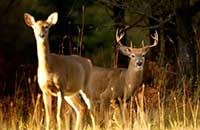By Louie Stout
 Deer Numbers Still LanguishingAs the deer season winds down and biologists start crunching the numbers, it remains quite apparent the Michiana deer herd is a far cry from what it was three years ago.
Deer Numbers Still LanguishingAs the deer season winds down and biologists start crunching the numbers, it remains quite apparent the Michiana deer herd is a far cry from what it was three years ago.
Sure, there were some dandy bucks killed by hunters. But the number of deer harvested based on preliminary estimates fell well short of where they were in 2012.
Some of that is by design. Both Indiana and Michigan went through a period of liberalization of doe permits to reduce crop damage and deer/car collisions.
But then the EHD (Epizootic Hemorrhagic Disease) swept through this region and killed a lot of deer in 2012 and 2013. That was a double whammy, especially when coupled with some pretty brutal winters.
Michigan is in the midst of a three-year program designed to offer more protection for does while Indiana has cut back on some of its antlerless permits in counties where harvest numbers were tumbling. If that trend continues, expect to see more cuts in antlerless permits.
Although still preliminary, 2015 harvest estimates hint at that.
While Michigan bases its harvest statistics on estimates derived from voluntary check stations and mail-in surveys after the season, Indiana utilizes a system that requires hunters to tag and report each deer they kill.
In Indiana, the statewide deer harvest as of late December showed around 119,500 deer harvested. The season is still ongoing, with late archery, urban hunts and special antlerless seasons still in play.
Even so, its quite possible the Hoosier deer harvest will fall short of the 120,073 deer taken last year and well short of the 2012 record of more than 136,000.
Since Indiana is still without a deer biologist to analyze the numbers, we wont know the county-by-county results for a while. The former biologist left a year ago to become Michigans head deer guy.
But if discussions this week with local butchers are an indication, the Hoosier harvest likely was the same or down in this region.
Both Steve Gill at DC Meats and Jim Aldrich of Jaworskis said the number of deer that came through their shops after bow season dwindles.
Gun season fell flat on its nose, said Gill. Three years ago we processed 800 deer for the entire season and now were down around 425. Many of those came during bow season. Our archery season processing has been high for the last three years but the gun season seems slow.
Is it possible that more deer hunters are taking bucks in archery season and doing less hunting thereafter? Or, could the low numbers of locally checked-in deer be due to new regulations that allow Hoosiers to check in deer online, avoiding the trip to a retail outlet?
Despite the low numbers, both processors said the deer they saw were healthy.
I didnt see anything exceptional but there were some nice, healthy deer, said Aldrich. Many of those people who brought in deer reported seeing quite a few.
In Michigan, wildlife managers estimate that the harvest was up perhaps as much as 17 percent in the Lower Peninsula, but declined some 19 percent in the U.P, compared to 2014.
On the bright side, biologists saw excellent body condition and antler development on many of the bucks that were registered at all voluntary check stations.
Although the U.P. saw lower harvest numbers, the bucks that were registered were mostly 3 1/2 or 4 1/2 years old. This reflects the low numbers of younger age classes due to winter effects and the continuing impact of predators.
p>Locally, District Wildlife Biologist Steve Chadwick said he anticipates the southwest Michigan numbers to be up slightly.Our numbers at check stations were up, but, frankly, they had nowhere to go but up, he said. Were seeing an overall recovery of the herd from the 2012 bout of EHD but still have a way to go.
CWD Concern
A more pressing concern for Michigan biologists is the confirmation of CWD (Chronic Wasting Disease) in central Michigan north of Lansing. Four infected deer have been discovered this year and biologists fear there could be more.
CWD is an awful, deadly disease that tends to attack mature animals. Its one of the most frightful diseases to impact a deer herd and not something that fades away like EHD.
We as sportsmen and managers should be focusing on that, said Chadwick. Research indicates that if this disease gets established its going to effect the deer herd long term. EHD is nothing compared to this; CWD impacts the older age class deer that hunters want to see on the landscape.
Furthermore, he added, the disease gets into the soil at which point it becomes an environmental issue.
Research shows that deer can walk through that area years later and become infected, Chadwick said.
Indiana hunters should be equally concerned. It might take a while, but CWD could find its way south of the state line if not held in check by Michigan managers.
The DNR has stepped up its efforts testing efforts in the infected area, testing deer at check stations and urging hunters to contact them of unhealthy deer.
How did the disease get there? Officials simply dont know.
In 2008, a CWD deer was discovered on a deer farm north of Grand Rapids, about 70 miles from the recent incident.
Thats too far to assume it came from there, but were not sure to what extent the disease is being spread, Chadwick said. And frankly, we arent sure where the epicenter is or if its confined to area of the recent outbreak.




